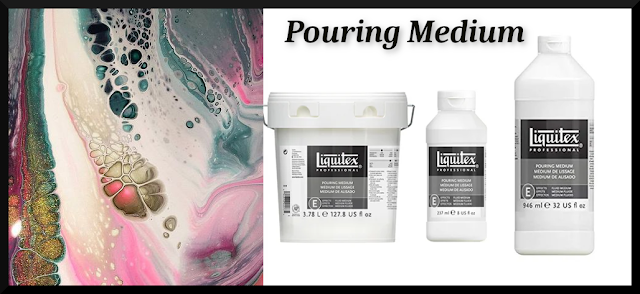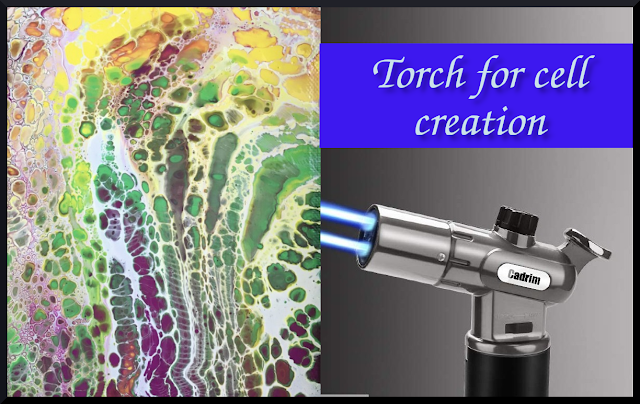Acrylic pour cells add a glamorous look and feel to the painting. The tiny, small, and large cells in various shapes are formed naturally and also artificially coaxed. But cell creation is not about just mixing some paints and pouring them out. Randomness and the strange ways in which colors interact with each other captivates the audience.
What causes cells in acrylic pouring?
Whenever there's a difference in density between the paint colors, cells are formed. The number of cells, size of cells are mainly dependent on the difference in the pigment densities of these colors.
The primary ways of attaining Pour Painting cells are:
By varying the density of paint
By Silicone oil
By using Pouring Medium
By using the flashlight method
By varying the density of paint
The optimal way of producing cells in your acrylic pour is by varying the consistency and density of the paint. Every paint color has a specific density/weight. You should know the density of each paint before you begin. Now layer the least dense paint on the bottom and most dense paint at the top. Now the denser paint pushes down, and the paint with less density rises to the surface; this is what causes the cells to occur.
Golden Acrylic Paints are famous for labeling each paint color with the density. Hence a lot of artists prefer to use Golden Acrylics. If you are using other brands where you do not know the density, try to assess the weight on a kitchen weighing scale to get an idea. You can also read Acrylic Pouring Guide to understand the step-by-step process involved.
By Silicone Oil
Silicone oil is the most popular additive for creating cells. It provides the creation of dynamic cells apart from expensive dimethicone.
Add a drop of silicone oil to the pouring mix. When this paint combines and is then poured onto the surface, silicone rises to the surface, creating circular holes. The beneath layer is exposed, and cells are formed.
Silicone is inexpensive, light, greasy, and creates a lot of cells. Not all, but only a few oils can divide the paint layers and slide against each other. A lot of artists use silicone, as they are easy to manipulate and predictable.
How much Silicone to Use?
Few drops are enough. Add them to the paint mixture and stir it briefly. Avoid mixing it for too long as it affects cell formation. Don't stir the paint after adding the silicone if you desire larger cells on your acrylic pour painting.
Even though the perfect cell formation recipe ratio is different for everyone based on the paints and medium used. You can start with this ratio:
- 1 part acrylic Paint
- 1.5 parts pouring medium
- 2-3 drops of silicone
Silicone can be purchased in many different forms. The WD-40 spray
lubricant is a good entry-level option for people starting out experimentation with cells. WD-40 is relatively cheap. However, this method of attaining cells is mainly debated if you
intend to keep your art for a long time or market it afterward.
By using Mediums
Pouring medium is the heart of Acrylic Pouring. Consistency and flow rate decides how the paints will interact with each other. This becomes the key. Hence liquid acrylics and high flow fluids are suitable for pouring art. There are several dynamics that must happen
in your paints for cells to form. To start with, first and foremost,
paints must be flowing smoothly.
If you have a heavy body acrylic paint, it must be thinned down, and medium plays the role here. Water alone cannot be used to thin the paint. Little water with the proper medium will work to retain the pigment strength.
Pouring medium can create small cells, so you do not have to add silicone if you are looking for small cells. Start by mixing paints using a good pouring medium, like Floetrol or Liquitex. Pouring mediums extend drying times, giving you more chance to work with cells when they have formed.
Liquitex Professional Pouring Medium is a common choice of the artists. It creates even levels along with extended drying time.
GAC 800 is another quality casting medium as it prevents cracks from occurring. The cracks occur due to uneven drying times between the lower and upper levels.
A disadvantage of the GAC 800 is that it can quickly become cloudy when dry. Therefore it is not suitable as a clear topcoat. They can be used with both artist-quality and craft acrylics.
Floetrol is another pouring medium that is cheap and effective.
What about other Oils?
A lot of new artists believe that they may use common cooking oils. You've heard that various types of oil are used to create cells, so why don't you catch olive oil or coconut oil from your kitchen? Do not try it.
These oils are much heavy to create cells on the surface of the bits. They'll also go that you think is too light, give it a try.
By Using the Flashlight method
A torch method is an alternate option. You can use a blow torch or a butane torch. Many artists use a culinary torch. When you run the flashlight lightly over the surface of the painting, it serves two purposes:
1. Air bubbles that had come into the surface have popped. Heated oil causes the paint to flow more.
2. The silicone oil rises to the surface, attracting colors together with it and creating movement from the paint, which produces cells.
Typically torching contributes to lots of little cells instead of bigger cells. If you're trying for larger cells, then you may not want to torch.
How to use a Torch to make cells on your Acrylic Pour Painting:
Once you've finished pouring the mixture onto the canvas, gently wave the flame over the painting about 6 or 5 inches at the areas where you want the cells. Do not hold the torch over one concentrated area for a long time, or maybe you end up with over-torching, which may lead to yellowing or even harm your art.
How to get Big/Large Cells
Well-planned execution with little patience will surely get you there.
1. Hold the torch on top of the painting and start burning the top layer of the painting. Lightly move over the painting surface. Let the bottom layer paint also heats up slightly.
2. Cover all the areas where you want the cells, continue for few seconds before tilting and stretching it. In this way, small cells initially grow bigger with bending and stretching.
3. If you use silicone or dimethicone, use only small amounts and do not mix more than one or two drops. The larger drops of oil in the paint stick together and move together while creating larger cells.
So which method should you use for creating cells in acrylic pour painting? Difficult to answer this one, as one size doesn't fit all! Try these methods yourself and see if you get the results you’re looking for. Do read Acrylic Pouring Tips to avoid common mistakes which people make during Painting.
Happy Acrylic pouring!


